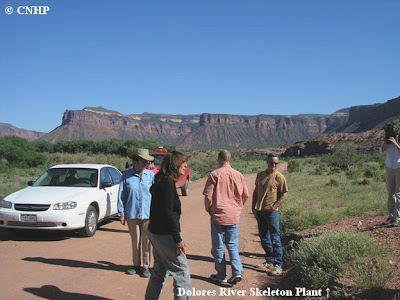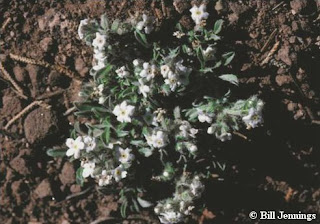If you have ever been to the tiny town of Gateway, Colorado, you no doubt remember being dumbfounded by your first glimpse of the Palisade. Truly one of Colorado's most jaw-dropping landforms, this giant red sandstone fin rises dramatically above the Dolores River. Sections of the massive rock walls rise 4,000 feet above the canyon floor. Located 50 miles southwest of Grand Junction, the uppermost portion of the Palisade is designated as a Wilderness Study Area (WSA) by the Bureau of Land Management. The Palisade WSA includes 26,000 acres of steep cliffs and rugged canyons.
Participants for CAP field trip in Gateway mill around a Dolores River skeleton plant (Lygodesmia doloresensis). From far left (Ellen Mayo, Peggy Lyon, Jeff Peterson, Jim Kelleher, and Betsy Neely).
This rugged Mesa County gem is home to Fisher Towers milkvetch (Astragalus piscator), horseshoe milkvetch (Astragalus equisolensis), Dolores River skeleton plant (Lygodesmia doloresensis), and Osterhout cat's-eye (Oreocarya osterhoutii). Our most recent Conservation Action Planning (CAP) meeting was held in Gateway, hosted by Rare Plant Conservation Initiative (RPCI) leaders Susan Spackman Panjabi and Betsy Neely along with Peggy Lyon, and focused on these four rare plants.
Osterhout cat's-eye (Oreocarya osterhoutii). Photo courtesy of Bill Jennings,
from CNHP's online Colorado Rare Plant Field Guide.
Our group included representatives from the CNHP, Bureau of Land Management, Colorado Dept. of Transportation, Mesa County Weed Department, Mesa County Transportation Department, Colorado Environmental Coalition, U.S. Fish and Wildlife Service, The Wilderness Society, The Nature Conservancy, and Mesa Land Trust.
CAP participants gathered around a Dolores River skeleton plant (Lygodesmia doloresensis). From far left (Betsy Neely, Jeff Peterson, Peggy Lyon, Ellen Mayo, Jude Sirota, Jim Kelleher).
The priority action areas for the workshop are the Dolores River floodplain and slopes below the steep cliffs, which rise on both sides of the river. This area is ranked by CNHP as having Outstanding Biodiversity Significance (B1). Although our workshop focused on rare plant species, records of breeding Peregrine Falcons and Black-throated Sparrows have also been documented here, as well as the state imperiled longnose leopard lizard.
Our group worked together to identify stresses to the rare plants (current, future and potential), then developed strategies to address them. We also identified the knowledge gaps and monitoring needs for the rare plant species.
Our next CAP meeting is scheduled for this Thursday, August 19, in Pagosa Springs.
Exploring the hills above the Dolores River looking for horseshoe milkvetch (Astragalus equisolensis). From left (Jeff Peterson, Ellen Mayo, Peggy Lyon, Betsy Neely, Jude Sirota, Jim Kelleher, and Susan Spackman Panjabi).







No comments:
Post a Comment
Thanks for your comment!
Please note that all comments are moderated, so there may be a delay of some hours (especially over the weekend or at night Colorado time) before your comment shows up.